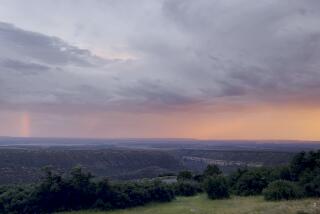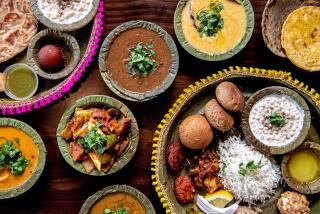Temples of Indian Art Treasures
- Share via
KHAJURAHO, India — Symbols of romantic love, devotion, ecstasy and other expressions of various levels of affection among humans are strong threads in the fabric of this country’s art, architecture, sculpture, literature and dance, one of the more widely known examples being this village’s “erotic” temple decorations.
Visitors to Khajuraho soon realize that the more sensational aspects of these magnificent carvings have been greatly overstated through the years, or at the very least tipped out of balance with the overall ode to joyful living that they portray.
What is even more surprising about the sandstone carvings in Khajuraho’s remaining 22 temples, all built during the 9th, 10th and 11th centuries, is that they pre-date the Renaissance, which is usually attributed with liberating the human form from rigid medieval strictures in art. Yet the wives and courtesans, gods and goddesses, rulers and rapscallions adorning Khajuraho’s magnificent temples all exhibit a fluidity of line, warmth and sensuality.
So who were these people who bestowed such a priceless artistic legacy upon us more than 1,000 years ago? About all we know is that they were a robust and obviously culturally advanced clan known as Chandellas, Rajput warriors who for some reason chose this site to build 85 temples to their gods and to celebrate their own way of life.
Study the ample figure and flowing lines of a young woman applying kohl to her eyes, another enticing her consort with ageless wiles. Then try to figure out how the art of medieval India could possibly have expressed human emotion in such a contemporary way.
Here to there: Lufthansa, British Airways and KLM fly to Delhi with one stop, Pan Am with several. Domestic lines get you to New York for a change to Air India’s Delhi nonstop. Indian Airlines flies Delhi-Khajuraho in 50 minutes, $1.50 by taxi to any hotel.
How long/how much? At least a full day and evening, more for a day-trip to Panna National Park, one of India’s largest, for a look at tigers, panthers, wild boar, Indian gazelles and bears in their natural habitat. A cab for visiting the temples will run you about $5 for half a day.
A few fast facts: The dollar recently bought 13 Indian rupees, making each worth .077. Again, October through March is best time for a visit. You may rent a bike for less than $1 daily for exploring the three main temple locations and the village.
Getting settled in: Hotel Chandela ($60 double) is, like all of these hotels, a short distance from the main (western) temple site. Chandela has a gigantic marble lobby with flower-decked fountain at center, two good restaurants, shopping arcade, handsome rooms, most of which open onto pool area. Very personal and thoughtful service, including a rose on your pillow at bedtime. Chandela recently joined the Taj Group of hotels, one of India’s finest.
Jass Oberoi ($62) is every bit as luxurious as the Chandela, with a white marble staircase curling upward beneath a lovely cupola, tennis courts, pool set in formal garden, a striking building of tiered architecture.
Khajuraho Ashok ($37) is an excellent value, considering that you get most of the above amenities. Rooms, either all red or green with contemporary furnishings, open onto the pool area. Lobby and rooms have wonderful photographs of temples.
Regional food and drink: To those unfamiliar with Indian food, the tandoor and its many culinary gifts will be a pleasant surprise. This earthenware oven is most associated with the Mogul invaders who swept south into India through Khyber Pass beginning in the 8th Century. It, like Pakistani Muslims’ food, turns mainly on the proper preparation of meat.
Tandoori specialties to try include: murgh ke tikke, boneless chicken marinated in yogurt; gosht sula mewari, a Rajasthani favorite of lamb morsels given the same treatment; kofta meatballs of lamb; shish kebabs often flavored with cashews, coriander, onions and green chiles, then put to the coals.
Vegetarians can look forward to the tandoor as well, bharwan mirch --green peppers stuffed with other vegetables and roasted, and paneer ka sulla-- a fresh Indian cheese marinated and dipped in batter before the oven.
Moderate-cost dining: Near the entrance to the western group of temples and tourist office you’ll find the Raja Cafe and Restaurant, a truly eclectic place run by a Swiss woman that offers Indian, Chinese and Western specialties. Curry dishes here always run less than $1, there is a cool rooftop area for a late-afternoon tea or coffee.
Hotel Chandela’s Rasana restaurant is an attractive room with wall hangings in vibrant orange, yellow and green folk embroidery. Our nargisi kofta of minced lamb in a curry sauce and nauratan curry of mixed vegetables was less than $4. Or you can get fancy and go for a hamburger steak.
The Jass Oberoi’s Apsara dining room is a study in cool serenity with wicker furniture, crisp linens and excellent service. The rogan josh, a Kashmiri lamb-curry dish cooked with yogurt, was one of the best of our trip.
On your own: Start with a visit to the western group of temples in a beautiful park-like setting kept immaculate with constant care. And be sure to give ample time to Kandariya Mahadeo Temple, Khajuraho’s largest, and to Lakshmana Temple, one of the most elaborately decorated. Sculpture on these and other temples in the group almost defy belief in the beauty and intricacy of their execution.
If you elect to make the trip to Panna National Park, go early in the morning or at sundown for the best chance of seeing animals moving about. A Jeep and guide for the 30-mile outing will cost about $30. You may also visit the diamond mines at Majhgawan, 35 miles distant, where stones of 500 carats have been taken.
For more information: Call the Indian Tourist Office at (213) 380-8855, or write (3550 Wilshire Blvd., Los Angeles 90010) for a brochure on Khajuraho, another on Indian food and a map of the country. Ask for the Khajuraho Package.
More to Read
Sign up for The Wild
We’ll help you find the best places to hike, bike and run, as well as the perfect silent spots for meditation and yoga.
You may occasionally receive promotional content from the Los Angeles Times.






